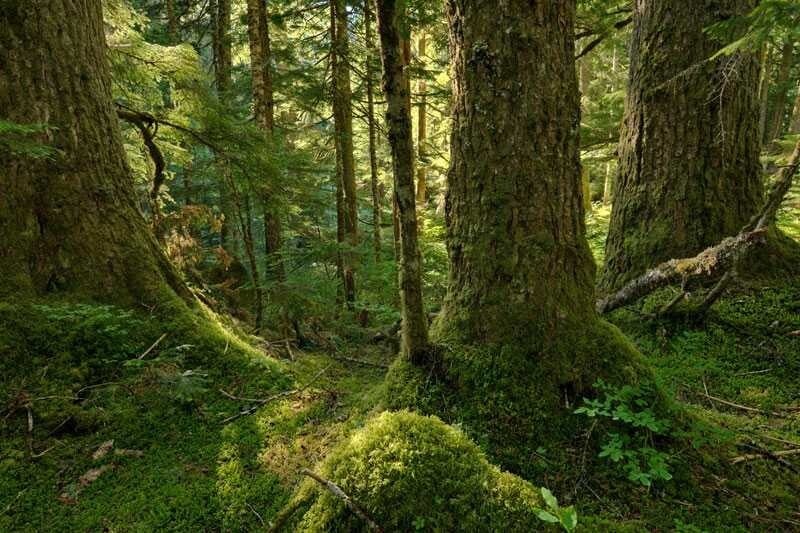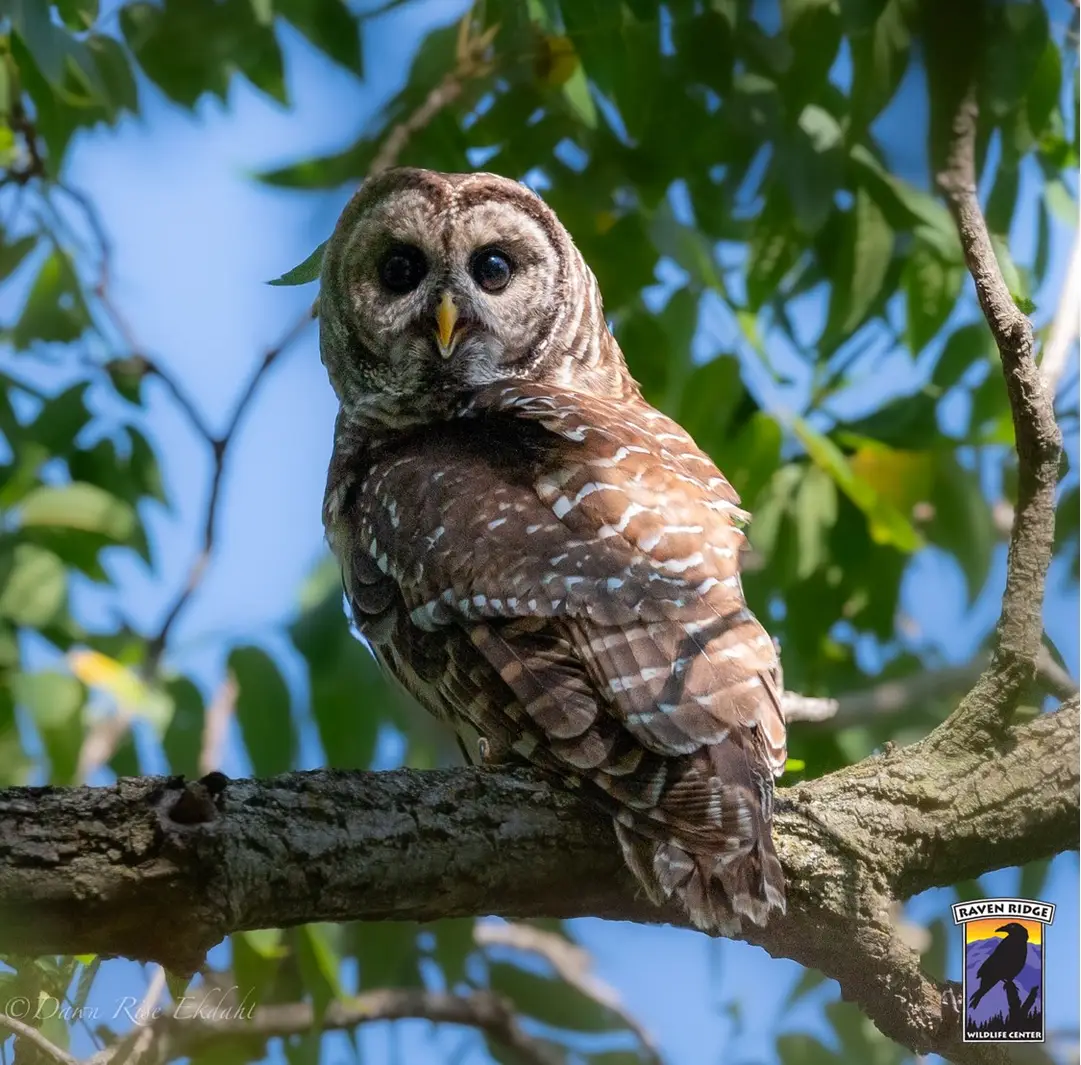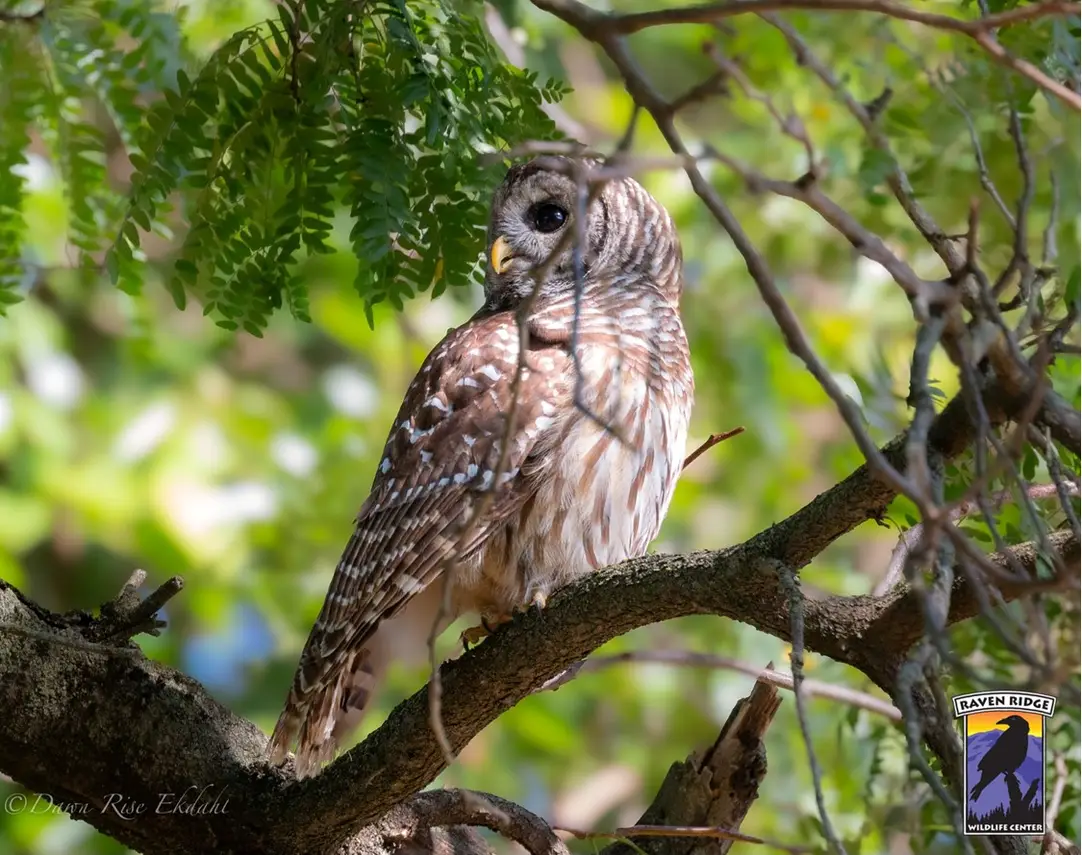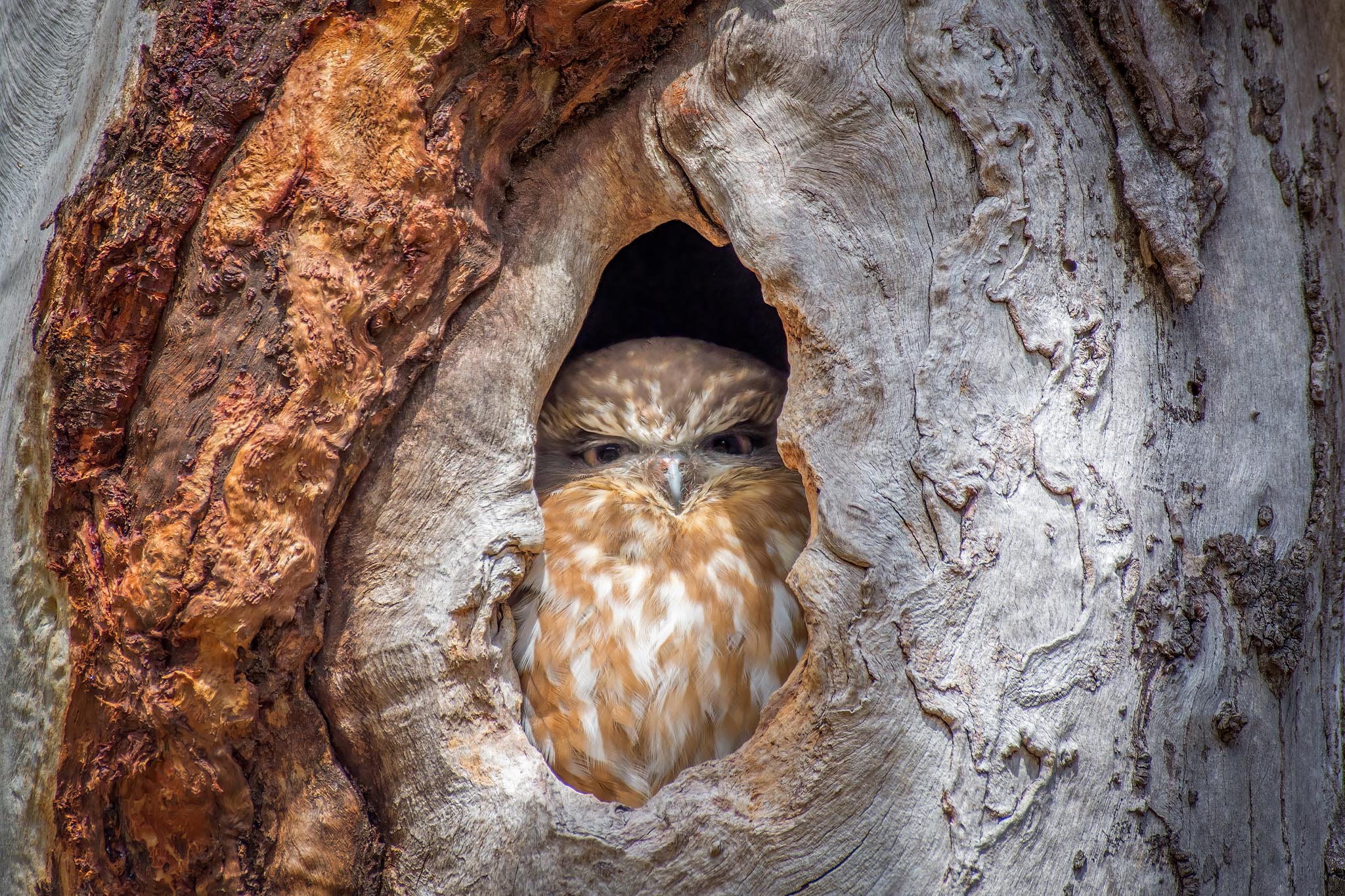

From New Mexico Wildlife Center
>Just how much of an owl's silhouette is created by feathers? Most of it! A recent windy day gave us a peek under the surface of American Barn Owl Ambassador Corazón's feathers. What you see on the top of her head is just the sandy-colored tips of her feathers, all layered together and slightly curved at the end. Underneath, you can see the full length of each feather and the way they create a dense, downy coat with surprising depth! Feathers provide very effective protection against the elements, especially the cold weather that we'll start to see pretty soon. Many birds' feathers also provide waterproofing protection, and the colors and patterns on feathers can be a great way for a bird to either blend in with their surroundings or stand out when they want a potential mate to notice them. For many owls, their unusually soft, velvety feathers also dampen the sounds created by their own body in flight, giving them the ability to fly silently! > >Corazón is a medium-sized owl with a wingspan of almost 4 feet, but she's light as a feather (well, many thousands of feathers, technically): she tips the scales at about 1.25 pounds! (567 grams)

>This set of 31 claws and talons allowS you to compare their size and appreciate the functional differences connected to the different behaviors in hunting and eating.
The GHO and Barn Owl are in the top row.
Are there any surprises for you in getting to compare them?
Pound for pound, the raptors have some pretty big pokey bits.

Photo by Johann Es
>Ein Boobookkautz, aufgenommen auf dem Großen Feldberg im Taunus, bei einem Greifvogel Workshop.
Google's Translation: >A Boobook Owl, photographed on the Großer Feldberg in the Taunus, during a bird of prey workshop.
Original Facebook Translation: >A boobook machete, taken on the Großen Feldberg in Taunus, at a bird of prey workshop.
Australian Boobook, thought to be a variety of the NZ Morepork/Ruru up until 1999.
This whole post threw me for a loop. Between Facebook calling it a machete to me wondering why a German was using the Australian word for owl (thought this was a damp Short Eared at first). I wonder how this little one came to be so far from home.
You spin my head right round, right round
I dunno, her dad is ex military and she's a helicopter pilot who did competitive helicopter games with the Soviets in the 70s from what I could find. I think she can use it.
Rolling Stone says it's a MAC-10, but that's the only reference I could find.
Johnson is not a middle-of-the-road politician. She owns a MAC-10 submachine gun — and received an A-rating from the NRA. On the campaign trail, she comes across like a pro-choice Ron DeSantis, vowing to give a voice to “really pissed off” Oregonians who are “terrified of the progressive left,” while blasting “wokeness” as “another form of intolerance.”
I was honestly shocked there isn't video of her blasting away at something as so many others seem to do any more.
I was also wondering if it was a Johnson Machine Gun and she was related to the inventor or that it was at least something historical.
Absolutely. If this special prosecutor thing doesn't work out, he can definitely land roles as Overly Strict Commanding Officer, or with the beard, Morally Grey Old West Sheriff.
I agree. Tired of this well done portrait of a terrible "judge" and ugly pictures of Smith. Let's flip that:.


With his disheveled hair and angry glare in 2the majority of pictures he just looks like Cody Johnston's disappointed father. I think he looked better less shaggy, though he could still lighten up a little bit.

My substitute partner at work today was more sympathetic than my normal coworker, so that made a big difference. I'm feeling pretty good compared to the weekend, but my throat is screwed up and my decongestant seems to have worm off after 8 hours as opposed to the 12 hours of relief promised to me by the box. 🤧
Yes, my actual medical depression is still properly treated, it's just a combo of job dissatisfaction and my girlfriend has started work after finishing college, and she works 3x 12 hr days Sat-Mon so my schedule is out of whack and I've trashed my already poor sleep hygiene trying to find a new routine. Doing my daily posts is the only thing occuring at "the proper time" anymore, so it at least syncs me up at the start of each day, and the happy comments throughout the day give me things to look forward to.
I caught the killer head cold she's been having for the last week as well, and it seems my body decided to speedrun it and I hardly left the bed over the weekend.
Everyone is always so supportive in the community, I'm always so glad I decided that if nobody else was going to make it active that it was up to me. I spend a lot of time on it, but I feel it is productive and the positive feedback I get makes the work feel more useful than any actual job I've had.
I know! Most people have no idea how important these old trees can be, and if you really have to take one down, at least check it for occupants first!
Lots of animals need them for shelter, as as we clear out more trees, we're not making their real estate market any better than we've been making our own in most places.
I was so happy with the community at !superbowl@lemmy.world this week!
We got posts from 5 other people this week, which I think is a record, and they were really good, and some were non-US as well.
I've passed 5000 comments, the majority of which have been within the community, and I'm over 900 posts. I've been able to maintain 3 posts a day for a while now.
Been seeing a number of new commenters as well and got another DM thank you from someone for posting happy stuff for them every day.
I've been depressed and now sick recently, so the community has been a very positive element in my life, so I'm glad everyone is still enjoying what I do.
Reading other communities, I feel people have been getting a little touchier and crude in some of their language, so I feel it is important to keep positive spaces here.
Not what I was expecting, but I like it! 😆
Rating all of Southern Africa's wildest cuisine!
I'd follow all their adventures!
Of course! I've been meaning to get something put in the sidebar for this at some point.
For the US, the best resource I've found is Animal Help Now.
They recommend the International Wildlife Rehab Council for the rest of the world and WIRES for Australia. Sorry, Australia, I couldn't think of a better way to phrase that, I'm not feeling well today. I count you as part of the rest of the world!
It's a tough job keeping up to date info. Many of these places are remote for the animals' sake, or even 1 or 2 person operations out of a home and aren't public per se. AHN recommends if there isn't a quick contact, to contact a vet to see if they can stabilize an animal until a proper person can be contacted.
I also look on the individual states' Game Commission sites for lists of licensed rehabbers, though the quality of those results naturally varies by state.
This link has some handy flowcharts on what to do if you find a X and think something is wrong with it.
This owl has the same energy as those people that live on the block where everyone goes to get that one Instagram photo.
I'm glad you enjoyed it!
It's always a pleasure to share these success stories with you all.

From Owl Rescue Centre
>Rescued from a gold mine in Fochville today. The tree that their parents decided was the best one to raise a family turned out to be the worst one as it was unfortunately chopped down. These two little fellas will be placed with one of our surrogate Spotted Eagle Owl parents this evening and will grow up as wild owls

From Raven Ridge Wildlife Center
>We are incredibly thankful for John and Jamie, who went out of their way to bring us a Barred Owl from Newville on a Sunday evening. They found the owl struggling to fly and walking across the road, and acted quickly to bring it to us. > >Upon examination, we discovered that the owl was severely dehydrated and underweight. It took days of intensive fluid therapy and hand-feedings for him to regain strength. After over a month of dedicated rehabilitation, this beautiful Barred Owl soared once more. > >This time of year is crucial for young owl is as they struggle to acquire the necessary hunting skills for survival. If you find a bird of prey on the ground for a prolonged period or unable to fly, please reach out to us or the nearest Federally licensed rehabilitation center for assistance.

Photos from Stephen Allen
A Boobook not in the mood to be photographed.

From Suffolk Owl Sanctuary (Facebook)
>Kibo's growing up so quickly! He's a cheeky chap, and captures many hearts as he greets visitors at his aviary. Who could resist those big sparkly eyes!
Kibo is named after the tallest peak in Africa, Mt Kilimanjaro.

From the Salisbury Journal
>AN OWL that was left to die in a bin has been released back into the wild after receiving treatment. > >Moyles Court Wildlife Hospital received a report from Cedar Vets in Verwood of a tawny owl that was found ‘dumped and left to die in a waste bin’. > >The bird was found with a broken wing, dehydrated and smelt of bin waste. > >After a lot of medical care, the owl was safely released back into society. > >A spokesperson for Moyles Court said: “Sadly this Tawny Owl was found dumped and left to die in a waste bin. > >“It was found by a compassionate passer-by and taken to Cedar Vets who passed him to us. The owl was dripping in smelly bin waste, as well as being dehydrated and starving he had also suffered a wing fracture. > >“We see and repair many fractured wings at our Wildlife hospital. > >“After receiving specialist treatment, nursing and rehabilitation here at our hospital he was once again strong and able to fly.”

From the Raptor Center
>There are many ways our human-centric world disrupts and causes injury to our feathered friends. Small acts can make a huge difference. > >This time of year, we see an influx of owls and hawks getting into a particular bit of trouble. Netting, like that used for soccer goals, and certain types of fencing have proven to be a formidable opponent of our raptors. Raptors may see a tasty critter on the other side of the netting and fly right into it while trying to catch their prey. > >Surprisingly, birds that sustain injuries from being entangled in netting can be some of the most difficult to treat. Often, the netting gets wrapped tightly around a bird's wings (and sometimes its legs) as it struggles to free itself often for several hours. This cuts off the circulation (blood flow) to those areas. Although there may not be obvious injuries when the bird is initially freed, a lack of adequate blood supply can result in tissues (skin, tendons, muscles) dying off over subsequent days. It can take time for the severity to reveal itself, so we want to not only thoroughly examine these birds immediately upon admission, but also monitor them closely for several days. > >While in some situations, sports netting is stationary and cannot be taken down, if you ARE able to lower netting or lay hockey or soccer nets flat when not in use, it can greatly reduce these types of injuries for our feathered friends. We also recommend not snacking around these nets as crumbs can attract rodents which in turn attract hawks and owls.

Photo by Happy Snapper
>This owl, named Chuckles, lives at the Fritton Owl Sanctuary in Norfolk. He hatched on 20th. May 2022 and arrived at the sanctuary on 20th. August. He had been bought as a pet but the owners decided they could not afford to feed him or give him the time he needed. > >The northern white-faced owl has a length of between 7.5 to 10 in. (190 to 255 mm) a wingspan of between 21.25 to 22.85 in. (540 to 580 mm). Their weight ranges between 6.5 to 9.7 oz. (185 to 275 g) with the average being 7.2 oz. (204 g). Females are larger than males. > > >It is found in a band across Africa between the Sahara and the Equator. It occurs in Benin, Burkina Faso, Cameroon, Central African Republic, Chad, Republic of the Congo, Ivory Coast, Djibouti, Eritrea, Ethiopia, Gambia, Ghana, Guinea, Guinea-Bissau, Kenya, Liberia, Mali, Mauritania, Niger, Nigeria, Senegal, Sierra Leone, Somalia, Sudan, Togo and Uganda. They inhabit dry savannahs and relatively sparse woods along watercourses, and are also found in dry open forests, woodlands with a closed canopy, forest edges and clearings. They are not found in deserts or dense tropical rainforests. > >This owl roosts in thorny bushes until dusk when it is feed time. It is generally insectivorous feeding on moths, beetles, crickets, spiders and scorpions, although they may take small birds, rodents and other small mammals. It hunts from an open perch from where it can drop unexpectedly onto its prey. > >This owl often nests in abandoned nests of other birds, anything from pigeons to eagles. They will also use tree hollows and have been known to use ground nests. This owl normally has 1 clutch per year, with egg laying recorded between January to December. Usually 2 or 3, sometimes 1 to 4, shiny, white eggs are laid at intervals of about 2 days, which hatch after about 30 days of incubation. The chicks are brooded and fed by the female with prey caught by the male. The young will move out onto nearby branches after about 4 weeks and can fly well at 30 to 32 days old. Both parents care and feed the chicks for at least 2 weeks after they have left the nest. The lifespan of wild birds is unknown, but in captivity they can live up to 30 years. > >This owl has a notable defence mechanism. When faced with a similar sized predator, like another owl slightly larger than itself, the bird flares its wings to appear larger. When faced with something much larger than itself, such as an eagle, it pulls its feathers inwards, elongates its body and narrows its eyes to thin slits. It is thought that it uses this ability to camouflage itself, and it shares the ability with relatives like the African scops owl. Many different types of owls have some ability to adopt a 'concealing posture', also known by the German word 'Tarnstellung', in which they squeeze and thin their body to look like a broken tree branch. Some types may also narrow their eyes to slits and fold a wing sideways across their chest in a Dracula-like manner to hide the lighter coloured feathers on their undersides. > >This owl is uncommon but widespread in suitable habitats and its conservation status is 'Least Concern', although as with most owls, it may be vulnerable to the use of pesticides and habitat destruction.

Photo by Tamara Ugaro
>A young Barred Owl (Strix varia) is on the lookout in New Jersey, USA.

Photos by Bryce Gaudian
>This opportunity came about when I had a trip already planned to be in Southern California to meet a new grandchild. I saw a post of these Barn Owls on Birds of Prey. Out of the blue, I messaged the photographer and asked if he would be willing to share the location. Within 10-minutes he gave me full details, stressing three times had to be there before 6 a.m. when the gates to the park would be opened. > >My friend who was staying in Topanga was willing to leave at 3:30 am to get there. We were the 2nd car in line. By 6 a.m. there were 27 cars full of photographers behind us. We got to the tree cavity by 6:03 am and literally had 6 minutes to take photos in pre-dawn light before these precious and curious Barn Owlets descended into the enormous tree cavity. > >It was an epic moment. Then one of the photographers who could tell was on Cloud -999 came up to me and said the Mother Barn Owl was at that moment in an enormous tree 1/8 mile away. > >He gave directions and ... here are the Barn Owls I was so tremendously given favor to photograph. The fulfillment of a lifetime dream. By the way, 15 feet from the Barn Owlets was a Western Screech Owl nest with 5 Owlets. > >I was able to get one photo of one of the parents to make these my 11th and 12th Owl species to date. I'm filled with gratitude to the California birder who trusted to give me the Barn Owls Location. It's been one of the major highlights of my Birding Adventures thus far.

From WildCareOklahoma
>Meet WildCareOklahoma patient #24-3218, great horned owl. This is not a typical position for an owl. This one is being weighed. Taking and tracking patient weights is one of the most important protocols followed at WildCareOklahoma. Changes and trends in weight can indicate the patient is improving and moving toward release or that something may be wrong when weight is lost. > >You may recognize this scale - it's the same kind used in pediatricians' offices!

From Hoo's Woods
>"Hey Ted, why are we turning around?" We were all set to leave with Blinky and Ted, our two screech owls, ready to give a program at Evansville Manor this week. Blinky, known for his rapid eye blinking, and Ted, who's red like a teddy bear, were excited to meet the residents and staff. However, as we were pulling out of the driveway we received a call that Evansville Manor had to evacuate due to a fire. Thankfully, everyone was safe, and we'll be rescheduling the program soon. Stay safe, Evansville Manor!

cross-posted from: https://lemmy.world/post/19705740
> In my post earlier today, I commented that I saw bird houses made of composite material (such as Trex) and was curious as to their thermal properties, since climate change is making many traditional house designs dangerous due to higher average temperatures.
>
> After reading the articles below, it sounds as though composite lumber heats up faster, retains heat longer reaches higher temperatures, and also loses heat faster than traditional, unfinished softwood.
>
> Article from Trex
>
> Article from a deck builder
>
> Even if the heat differential won't kill the birds, it seems to have greater potential to stunt nestling growth and to increase dehydration risk.
>
> I didn't find any articles from birding groups about them being dangerous, but it seems very recent that they have been taking note of increased nest box death, so it may not have much research into it yet.
>
> While the initial thought was something like this should last longer, stay prettier, and be easy to maintain sounded great, seeing it both holds more heat during the day and loses more at night sounds like a negative in both directions. It may be best to stick with unfinished wood.
>
> I'm curious to hear anyone's thoughts on this. Don't take my hour of research as gospel. It just came up in conversation and I haven't seen this discussed.

In my post earlier today, I commented that I saw bird houses made of composite material (such as Trex) and was curious as to their thermal properties, since climate change is making many traditional house designs dangerous due to higher average temperatures.
After reading the articles below, it sounds as though composite lumber heats up faster, retains heat longer reaches higher temperatures, and also loses heat faster than traditional, unfinished softwood.
Even if the heat differential won't kill the birds, it seems to have greater potential to stunt nestling growth and to increase dehydration risk.
I didn't find any articles from birding groups about them being dangerous, but it seems very recent that they have been taking note of increased nest box death, so it may not have much research into it yet.
While the initial thought was something like this should last longer, stay prettier, and be easy to maintain sounded great, seeing it both holds more heat during the day and loses more at night sounds like a negative in both directions. It may be best to stick with unfinished wood.
I'm curious to hear anyone's thoughts on this. Don't take my hour of research as gospel. It just came up in conversation and I haven't seen this discussed.

Photos by Phil Hill
>A few from yesterday with the Barn Owl..started off with very early poor light then as the light improved time for bed(roost)..that's wildlife for you there's always tomorrow...

Photos from interestedbystandr
Powerful Owl with a bat.

We ventured to the garden store to get some fall decor, and they had a wide assortment of owl merch.
This birdhouse was the first to catch my eye. It was next to some nice looking birdhouses made of different colored Trex type material. I wonder what the heat retention of Trex is compared to wood. They would certainly last longer and be easier to clean.




